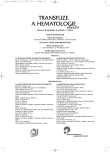A combined antigen-antibody HCV detection assay
Authors:
J. Masopust 1; J. Kracíková 2; V. Němeček 3; R. Procházková 4
Authors‘ workplace:
Transfuzní oddělení, Masarykova nemocnice v Ústí nad Labem
1; Transfuzní oddělení, Fakultní nemocnice Královské Vinohrady, Praha
2; Národní referenční laboratoř pro virové hepatitidy, Státní zdravotní ústav, Praha
3; Transfuzní oddělení, Krajská nemocnice Liberec
4
Published in:
Transfuze Hematol. dnes,11, 2005, No. 4, p. 141-147.
Category:
Comprehensive Reports, Original Papers, Case Reports
Overview
Introduction.
Besides implementation and considerable improvement of screening tests for anti-HCV detection in blood and blood components donors, hepatitis C virus remains the significant risk of post-transfusion hepatitis. The aim of our study was to evaluate the possibilities of introduction the assay for combined detection of HCV antigen and HCV antibodies in the Czech republic.
Materials and methods.
From January to April 2005 1164 serum samples of blood and blood components donors were tested simultaneously by Monolisa HCV Ag-Ab Ultra (BioRad) and Monolisa anti-HCV Plus Version 2 (BioRad) (group 1). Following samples were tested by Monolisa HCV Ag-Ab Ultra: 106 HCV RNA positive and anti-HCV positive samples (group 2); 15 samples from patients with proved HBV infection (group 3); 41 samples reactive in 3 EIA anti-HCV tests or RIBA 3.0 HCV positive (group 4); 109 samples reactive at least in one anti-HCV EIA test and RIBA 3.0 indeterminate or negative (group 5); panel of samples with low titre anti-HCV (group 6); panel of samples with mixed titre anti-HCV (group 7) and 2 samples from blood donor HCV RNA positive, anti-HCV negative (group 8).
Results. Group 1:
one unspecific reactivity only in Monolisa HCV Ag-Ab Ultra (specificity 99,91 %); group 2 : 106 positive samples (100 %); group 3 : 15 negative samples (100 %); group 4 : 38 reactive samples (92,7 %) a 3 negative samples (7,3 %); group 5 : 40 samples anti-HCV (BioRad) reactive and HCV Ag-Ab (BioRad) negative (36,7 %), 23 samples anti-HCV (BioRad) negative and HCV Ag-Ab (BioRad) reactive (21,1 %), 12 samples reactive in both tests and 34 samples negative in both tests; group 6 a 7: all results were accordant with panels; group 8: both samples were negative by HCV Ag-Ab (BioRad) (S/CO 0,13 a 0,58).
Discussion.
Our pilot study shows that Monolisa HCV Ag-Ab Ultra assay is highly specific. It shortens diagnostic window in comparison to antibody assay by 17-49 days (literature data), test sensitivity is increased by extension of the interval of „the grey zone“ from S/CO 0,50. It is suitable to consider the introduction of combined HCV antigen-antibody assay in transfusion service in the Czech republic. However, further studies with routine testing of blood and blood components donors are necessary for real evaluation of benefit of HCV antigen testing.
Key words:
HCVcAg, anti-HCV, blood donors, enzyme-linked immunosorbent assay
Labels
Haematology Internal medicine Clinical oncologyArticle was published in
Transfusion and Haematology Today

2005 Issue 4
Most read in this issue
- Could lupus anticoagulants presence influence anticoagulant treatment in patients with antiphospholipid syndrome?
- A combined antigen-antibody HCV detection assay
- History and present of the treatment of lymphoblastic leukemia in children
- ProC®global in patients with antiphospolipid antibodies
